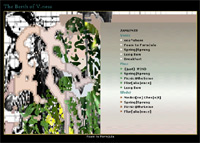|
In recent years the literary world has enthusiastically adopted
the benefits of the internet, using email, websites, discussion
boards, and in some cases publishing work online. But most remain
unfamiliar with new media writing and its variations: digital
fiction; hypermedia; flash poetry; electronic literature; hypertexts;
eliterature; multi-media texts; web-based narratives . . . the
list is long and esoteric.
 Of
course, new media writing itself does not yet know what it is.
For example, the 100+ submissions to the 2001 trAce/Alt-X New
Media Writing Competition featured 70 different
namings of the types of work submitted, and the entrants proposed
an equal number of self-titles for their artistic profession,
ranging from hacker/poet to hypertextualist. Of
course, new media writing itself does not yet know what it is.
For example, the 100+ submissions to the 2001 trAce/Alt-X New
Media Writing Competition featured 70 different
namings of the types of work submitted, and the entrants proposed
an equal number of self-titles for their artistic profession,
ranging from hacker/poet to hypertextualist.
Despite their persistent identity crisis, all new media writings
do have at least one thing in common – they must be viewed
through the medium of an electronic display, usually a screen
but sometimes just audio, via a PC or Mac, a laptop, a PDA, a
mobile phone, data projector, or perhaps even a giant outdoor
image. Their uniting characteristic is that the computer is an
essential component of the writing and without it the work would
not exist.
Another common feature of much, but not all, new media writing
is hypertext, a method of structuring information in such a way
that related items are connected, or threaded, together by links
called hyperlinks. The items so linked may be text, but increasingly
include other media, such as graphics, sound, animation or video,
and in this way hypertext becomes hypermedia.
E-books are generally not considered to be new media writing
because most are simply digitalised versions of conventional linear
print texts. A few are experimental in nature, such as distilled
miniaturised hypertexts, or downloadable origami-type texts to
be printed out, cut and folded, but for the most part e-books
have arisen from print culture and have little connection with
new media writing.
The first electronic literature texts accessible to general readers
were created in the mid-1980s, and since then there has been a
proliferation of stories, poems, and multimedia works both on
the web and on CD-ROM. This guide provides an introduction for
those new to the form and points to a number of starting points.
However, it does not claim to provide an exhaustive list and readers
are encouraged to pursue their own strands of enquiry in this
very diverse field.
Hypertext :
active text : web-specific writing : new media work : new media
writing : net literature : Net Art : feminist hypermedia : poetry-multimedia
installation : web integrated writing : moving poetry : storytelling
: multimedia : hypertext poem : net-art-writing : Linguistic Aestheticism
: journalism : new horizon breakthrough idea exposition : internet
based narrative : net.art : Possible Art : hyperfiction : Interactive
Fiction : Hypertext Fiction : hypermedia : digital literature
: lit[art]ure : net.lit : Hypertext Art : post-ultra modern digital
art : public literature : Net-narrative : community art : net-essays
: cyberpoetry : Digital Exploration : mutations :digital narrative
: Net-specific hypermedia poetry : Hypermedia Literature : revolutionary
web-specific writing : hypermedia poetry : interactive literature
: randomly created web narrative : interactive poetry : Art :
Proximism : Theater of Consciousness : Poetry : Confrontationalism
: InterMedia Theater : Hyper-Essay : Informational Sculpture :
Transformationalistic : Self-generating computer installation
: hyperlinked : netArteFact : Web Poetry : Web Art : Web projects
: electronic literature : Organic hypertext : poetry and prose
: interactive artwork : hypermedia : byte-o-mania : web animated
visual poetry : A web-based poem : online content.
|

